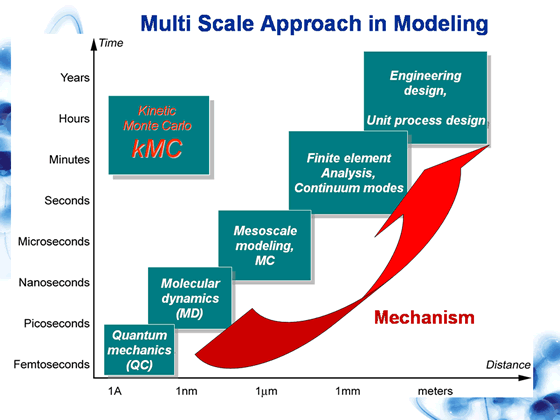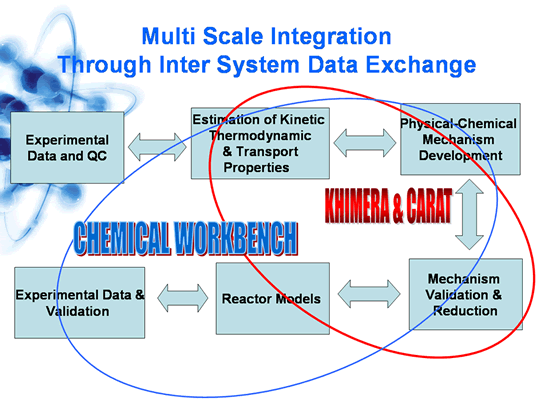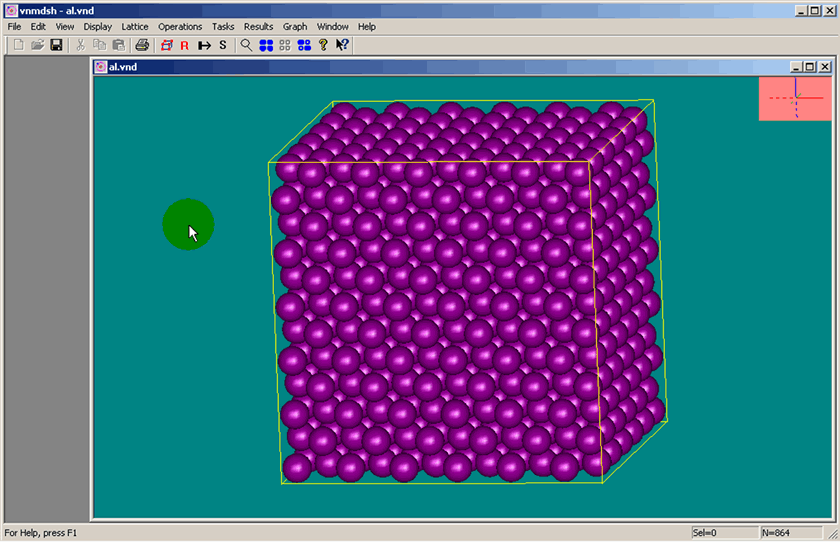Bridging atomic and macroscopic scales for materials, process, and device design. US-Russian Workshop on Software Development (SWN2003)
This was, probably, the first conference meeting when people openly declared that they are seeking the connections between the theory (theories),
their modeling implementations and respected software tools for atomistic (atomic) scale physics and the properties of materials
(media) at the manufacturing or better to say designing physical scale. In spite that these kinds of sections started to appear in most of related
conferences, symposia, the directly proclaimed goal of such a sharp, on target proportion appeared seems at first at this meeting.
As soon as our goals had been spearheaded into the same direction, albeit are of more wide subject fields, we have taken part in this meeting
and would like to comment and discuss the talks, and events, which happened at the meeting on November 13-15, 2003
at Arizona State University, Tempe, Arizona -
with the program of the workshop at -
"Remarks on Some Reports Presented at this meeting - SWN2003"
This workshop-symposium was primarily the meeting of researchers working in chemistry (not a chemical technology)
and materials science workers. The most of reports and discussions were around the problems characteristical
for chemistry - atomic (molecular) scale problems. The software packages demonstrated at the symposium
are probably among the finest in this category - one scale around of molecular size chemical reactions and interactions software
solutions. The mode in which in chemistry the multiscale approach is being implied can be illustrated via the following three
slides from the presentations by the Sarov Laboratories and the Kintech Ltd.



Actually this is the kind of data related to each scale and being transferred between the scales. But this is not the multiscale modeling, this relationship between the scales phenomena we call the
"pseudoscaling" type of.
Though, there were no one, but my talk which directed attention to the issues of interscale, separate
two or more scales physical and mathematical problems, and what is the most important - the solutions of these
problems and the tools evidently suited for these tasks.
There were only two other reports:
(Theresa Windus -- Pacific Northwest National Laboratory) Collaboratory for Multi-scale Chemical Science (CMCS) is a DOE sponsored environment......
and
(Don Nicholson -- Oak Ridge National Laboratory). The First Principles Continuum Model (FPCM)....
which were structured as the ones about the multiscale topics.
Still, unfortunately these were not talks about scaling procedures or theory, not to say about results of scaled tasks. These were talks about intentions in these specific labs to have
some progress in the area of scaling methods for nanotechnologies. Some words on the attitude and understanding of multiscaling phenomena
based on their announced programs have been written in the following section of this website -
.
Meanwhile, our report was primarily focused on the scope of already well understood issues of the
different Scales Physics Communications. Due to professional specifics of the meeting's participants,
no one at the meeting seems any time previously had heard about the any other tool then the homogenization theory.
And when I explaned why the homogenization theory actually can not be the scaling tool,
the audience was caught by surprise.
“Multiscale Physical Problems Require New Scaled Software. Few Examples of Exact VAT Problem and Software Solutions.”
Travkin V.S. and Gordienko Y.G.
ABSTRACT
The scaled physical problems in great number of studies are being modeled and simulated using actually the one only scale mathematical models and software. Mostly it is done for problems stated as for the "bottom-up" physics. Meanwhile, everyone understands that the both the "bottom-up" and the "top-down" directions (ways) physics and corresponding mathematical models should be consistent in their results, no matter what was the starting point - the lower scale model or the upper scale one.
We demonstrate the exact two (2) scale VAT solutions and simulating software peculiarities for the diffusive, convective transport, as well as for the electrodynamics problems of different scales. Direct involvement of morphology characteristics including the digitized cross-surface images of the samples of materials ( Al-Mg single crystals), superlattices, and 3D forms of heterogeneous structures into the different scales simulations was the inseparable part of the scaled problem statements and solutions.
Simulation of diffusion was performed for investigation of anomalous transport properties in plastically deformed Al-Mg single crystals. Digitized 2D surface images were used for morphological analysis, computation of the spatial correlation functions and simulation for different scales of Al-Mg samples. The analytical calculations were verified by computer simulation for different types of simulated random heterogeneous media with the same level "defect substructure content" (porosity) as it was observed in Al-Mg samples. As a result the different types of dynamics of diffusion processes (non-Gaussian shape of average particle density or "deformed Gaussian") were observed for different patterns of heterogeneous media with the same "defect substructure content" (porosity). One of conclusions obtained is that measures of volume fraction (as well as measure of uniform spatial correlation) are not enough for characterization of diffusion transport properties in highly heterogeneous media.
Some of the problems reported are well known, but were solved insufficiently when being stated as for one physical scale. We also apply the consistency of "bottom-up" and "top-down" theoretical VAT mathematical constructions and the software to the experiments over the heterogeneous media and to experimental data reduction.
Our presentation had the size of around 5MB and can be available at special
request.


